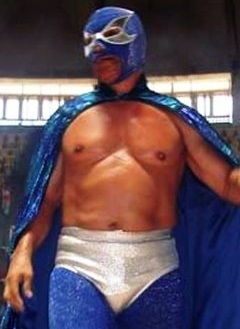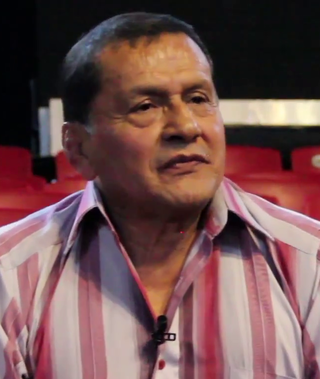
Eduardo Aníbal González Hernández, better known by his ring name Juventud "Juvi" Guerrera, is a Mexican professional wrestler currently performing on the independent circuit.

Jorge Ernesto Guzmán Rodríguez, best known under his ring name, El Hijo del Santo, is a Mexican luchador enmascarado and political activist. He is the youngest child, out of eleven, of El Santo. Guzmán has also followed in his father's footsteps, as he has starred in several luchador films.
Roberto Gutiérrez Frías, best known under the ring name El Dandy, is a Mexican professional wrestling trainer and retired professional wrestler. He is the cousin of professional wrestler Juan Conrado Aguilar, known as El Texano, and the uncle of Aguilar's sons, who wrestle as El Texano Jr. and Súper Nova. While he had a retirement tour in 2014, Gutiérrez has wrestled most recently in March 2019. Gutiérrez has wrestled for most major Mexican promotions, including Consejo Mundial de Lucha Libre, Lucha Libre AAA Worldwide, Universal Wrestling Association, World Wrestling Association, and International Wrestling Revolution Group. In addition, he has worked for the US-based World Championship Wrestling as well as the Japanese Super World Sports and the International Wrestling Association of Japan.

César Cuauhtémoc González Barrón was a Mexican luchador enmascarado. He was known best as Silver King, but also had an extensive stint as the third wrestler to portray the Black Tiger character. He was the son of luchador Dr. Wagner and the brother of Dr. Wagner Jr. González worked for many years with El Texano as the tag team "Los Cowboys," winning tag team championships in both Mexico and Japan.
Erick Francisco Casas Ruiz is a Mexican professional wrestler currently working under the ring name Heavy Metal for AAA. He is the son of referee Pepe Casas and part of the Casas wrestling family; the brother of Negro Casas and Felino.
Tomás Díaz Mendoza, best known by his ring name Villano IV, is a Mexican luchador. He has wrestled for Universal Wrestling Association (UWA), Lucha Libre AAA Worldwide (AAA) and World Championship Wrestling (WCW). While popular and successful in Mexico, he frequently performed as a jobber in WCW. The other sons of Ray Mendoza who have used the name "Villano" include Villano I, Villano II, Villano III, and Villano V. He is the last surviving member of the Villanos siblings.

Genaro Vázquez Nevarez is a Mexican professional wrestler and trainer, best known under his ring name Blue Panther. He made his in-ring debut in 1978. Since then, he has worked for most major Mexican professional wrestling promotions, including the Universal Wrestling Association (UWA), Consejo Mundial de Lucha Libre (CMLL) and Asistencia, Asesoría y Administración (AAA). He was one of the first wrestlers to leave CMLL for AAA when it was created in 1992, but returned to CMLL in 1997 where he has competed ever since.

José Casas Ruiz is a Mexican professional wrestler and professional wrestling trainer working for Lucha Libre AAA Worldwide (AAA) under the ring name Negro Casas. He is the son of former wrestler turned referee Pepe Casas, and part of the large Casas wrestling family; brother of professional wrestlers El Felino and Heavy Metal and uncle of Puma, Tiger, Canelo Casas, Rocky Casas, Danny Casas and many more.

José Luis Rodríguez Arellano is a Mexican Luchador Enmascarado who wrestles under the ring name Dos Caras. His most active years were in the 1970s and 1980s, and he achieved his greatest success in Mexico's Universal Wrestling Alliance (UWA), where he won the UWA World Heavyweight Championship three times. He has been called "the greatest heavyweight ever to come out of Mexico". He is the creator of the Dos Caras Clutch, a hammerlock head scissors pinning combination.

Juan Baños was a Mexican luchador enmascarado, or masked professional wrestler better known by the ring name Lizmark. The name was taken from the German battleship Bismarck. He was a multiple-time champion, having held singles and tag team championships in both Empresa Mexicana de Lucha Libre / Consejo Mundial de Lucha Libre (EMLL/CMLL) and Asistencia Asesoría y Administración (AAA). In 2001, Lizmark was inducted into the Wrestling Observer Newsletter Hall of Fame. His nickname was El Geniecillo Azul, which is Spanish for "The Little Blue Genius". He has two sons who are also professional wrestlers, Lizmark, Jr. and El Hijo de Lizmark.

Francisco Javier Pozas is a Mexican professional wrestler, or luchador, who is best known under the ring name El Pantera, but has also worked as Pantera II, El Manaya, América, Tritón and Tanaka over the years. Pozas made his wrestling debut in 1985, working as an enmascarado with a panther-inspired mask to go with his ring character of "El Pantera". Over the years Pozas has worked in Mexico, Japan and the United States; In Mexico he has worked for Consejo Mundial de Lucha Libre (CMLL), Asistencia Asesoría y Administración (AAA), International Wrestling Revolution Group (IWRG), in Japan he's worked for Universal Lucha Libre (ULL) and All-Japan Pro Wrestling (AJPW) and in the United States he's most known for his work in the World Wrestling Federation (WWF) from 1997 to 1999 and Chikara where he has worked shows since 2007. In 2006 Pantera lost his mask as a result of a match. He, however, continued wearing the mask when working for Chikara and in 2011 also began wearing it again in Mexico.

Juan Alvarado Nieves was a Mexican luchador. He was best known under the ring name El Brazo, which he used since his debut in 1980. Alvarado was part of the Alvarado wrestling family, which includes his father Shadito Cruz, five brothers who used the "Brazo" name at some point and several third-generation wrestlers.

Arturo Beristain is a Mexican retired professional wrestler, or Luchador in Spanish, who works as a wrestling trainer at the Mexican professional wrestling promotion Consejo Mundial de Lucha Libre's (CMLL) gym in Mexico City, Mexico. Beristain is best known for working under two different ring names, Talismán and El Hijo del Gladiador; both personas started out as enmascarados, or masked, and Beristain lost both masks in Luchas de Apuestas. He lost the Talismán mask to Atlantis in 1984 and the Hijo del Gladiador mask to Rencor Latino in 2000. As Talismán, Beristain won the Mexican National Welterweight Championship twice, the Mexican National Middleweight Championship and the Mexican National Lightweight Championship. As el Hijo del Gladiador he has won the CMLL World Trios Championship with Gran Markus, Jr. and Dr. Wagner Jr. and the IWRG Intercontinental Middleweight Championship. When Beristain lost the "Hijo del Gladiador" he was announced as "Arturo Beristain Ramírez" to further the storyline that he was actually the son of wrestler "El Gladiador", but his last name is not actually Ramírez.
Águila Solitaria is a Mexican Luchador enmascarado, or masked professional wrestler. Águila Solitaria's real name is not a matter of public record, as is often the case with masked wrestlers in Mexico where their private lives are kept a secret from the wrestling fans. His ring name, Águila Solitario, is Spanish for "Lone Eagle", which is reflected in the eagle wing design on his mask. Águila Soltaria made his professional wrestling debut in 1978 and since 1997 has only wrestled a limited schedule.

Ramón Ibarra Banda is a Mexican luchador, or professional wrestler, working under the ring name Super Parka. Ibarra previously worked as Volador from 1990 until 1997 and as Super Parka ever since. Ibarra is the father of Luchador Volador Jr., the grandfather of Flyer and the uncle of L.A. Park, who was the inspiration for the "Super Parka" character. Throughout his career he has worked for most of the major Mexican wrestling promotions including Consejo Mundial de Lucha Libre (CMLL), Lucha Libre AAA Worldwide (AAA), International Wrestling Revolution Group (IWRG) and the World Wrestling Association (WWA) but works primarily on the Mexican and US independent circuit. While he has been unmasked in Mexico, Ibarra still wears the "Super Parka" mask when wrestling in the United States.
Roberto Castillo is an American professional wrestler currently working on the independent circuit in Mexico and Southern California under the ring name Misterioso. Together with Volador, Misterioso formed one of the most popular and talented teams in Mexico in the early to mid-1990s.

José Luis Alvarado Nieves was a Mexican luchador best known under the ring name Brazo de Plata, a name he had used since his debut in 1977. He is also well known for his appearances in WWE as Super Porky. Alvarado was a member of the Alvarado wrestling family which includes his father Shadito Cruz, five brothers who used the "Brazo" name at some point and several third-generation wrestlers who have appeared over the last couple of years.
Espanto Jr. is the most recognizable ring name of Jesús Andrade Salas, a retired Mexican luchador, or professional wrestler. Over his 25-year-long career, Andrade worked under a number of different aliases, most importantly as Espanto Jr., later on as El Santo Negro, and as the first person to work as Pentagón. Andrade was forced to retire from wrestling after suffering a life-threatening injury during a match that briefly left him clinically dead before being revived in the middle of the ring.

Esteban Mares Castañeda is a Mexican luchador, or professional wrestler, better known by the ring name Black Terry. Wrestling since 1973, he was once part of a group called Los Temerarios alongside Jose Luis Feliciano and Shu El Guerrero. He has previously worked as the masked character Guerrero Maya where he formed the group called Los Guerreros Del Futuro with Guerrero del Futuro and Damian El Guerrero. He is the father of wrestler Guerrero Maya Jr. although the relationship is not officially recognized due to Guerrero Maya, Jr. being a masked wrestler.

Juicio Final (1995) was the name used for two major professional wrestling shows, scripted and produced by Consejo Mundial de Lucha Libre (CMLL). The shows took place on December 1 and December 15, 1995 in Arena México, Mexico City, Mexico. The shows served as the year-end finale for CMLL before Arena México, CMLL's main venue, closed down for the winter for renovations and to host Circo Atayde . The shows replaced the regular Super Viernes shows held by CMLL since the mid-1930s. This was the seventh year that CMLL used the name "Jucio Final" for their year-end show, a name they would use on a regular basis going forward, originally for their year even events but later on held at other points in the year.













